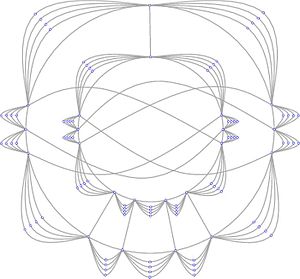
In mathematics, a topological graph is a representation of a graph in the plane, where the vertices of the graph are represented by distinct points and the edges by Jordan arcs (connected pieces of Jordan curves) joining the corresponding pairs of points. The points representing the vertices of a graph and the arcs representing its edges are called the vertices and the edges of the topological graph. It is usually assumed that any two edges of a topological graph cross a finite number of times, no edge passes through a vertex different from its endpoints, and no two edges touch each other (without crossing). A topological graph is also called a drawing of a graph.
An important special class of topological graphs is the class of geometric graphs, where the edges are represented by line segments. (The term geometric graph is sometimes used in a broader, somewhat vague sense.)
The theory of topological graphs is an area of graph theory, mainly concerned with combinatorial properties of topological graphs, in particular, with the crossing patterns of their edges. It is closely related to graph drawing, a field which is more application oriented, and topological graph theory, which focuses on embeddings of graphs in surfaces (that is, drawings without crossings).